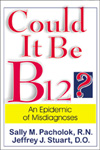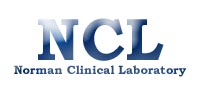|
Norman9,12,13 used the uMMA test to screen senior residence (over age 65)
(N = 68) independently living in a retirement apartment and reported 12% with
elevated uMMA (normal uMMA < 5.0) and 7% with uMMA levels above 7 and below
normal serum B12 levels. Using today's normal standard for uMMA of (< 3.8)
at least 22% of the subjects showed metabolic deficiency. Reporting the high
prevalence of B12 deficiency in seniors coupled with the high incidence neurologic
disease in nonanemic B12 deficient individuals alerted researchers and the public
to the B12 deficiency epidemic. These findings were spotlighted in both the
Cincinnati, OH and national press to inform physicians and the public to the
dangers of undetected B12 deficiency. An editorial in the Cincinnati Enquirer,
August 19, 1985, notes
| "Some aged patients with problems of vision, memory
loss, paranoia and perhaps dementia have been erroneously diagnosed as having
AD when they were suffering from vitamin B12 deficiency." | |
Similarly, from
1987 to 1992, The Vitamin B12 Report was mailed to Cincinnati physicians and
selected national doctors, hospitals, and clinics.45 Subsequently, Norman and
Morrison14 identified 7 % of 809 elderly individuals as vitamin B12 deficient
with high uMMA (normal < 4.0). The lower prevalence of vitamin B12 deficiency
identified in this later study may be attributed to increased physician/public
awareness of B12 deficient individuals without anemia, different study populations,
and increased consumption of multivitamins and/or B12 fortified cereals.
It has been estimated, depending upon the population, that from 5% to 15%
of elderly individuals will have vitamin B12 deficiency.28 Of persons age 60,
up to 30% have atrophic gastritis. Over age 70, up to 50% have atrophic gastritis.46
Atrophic gastritis contributes to vitamin B12 deficiency but does not affect
the absorption of crystalline B12.47 Therefore, the Food and Nutrition Board
has recommended that the RDA for vitamin B12 for adults of all ages be increased
to 2.4 micrograms from the 1989 RDA of 2.0 and advised that elderly people consume
vitamin B12 fortified foods (e.g. cereals) and/or vitamin B12 supplements.47
Strict vegetarians are at particular risk for developing B12 deficiency within
two years.5 Serious neurologic deterioration may occur in infants that develop
B12 deficiency through a nursing mother on a strict vegetarian diet or a mother
with untreated pernicious anemia. Persistent B12 deficiency47A and long-term
neurologic consequences can occur from a B12 deficient diet early in life.47B
Mild B12 deficiency in older Dutch individuals could be attributed to inadequate
B12 intake or atrophic gastritis in only 28% of the population and those taking
supplements (7.8 micrograms per day) had similar SMMA levels as those not taking
supplements.1 Stabler et. al.48 found that multivitamin supplementation (6 micrograms of B12) was not associated with lower SMMA levels in their study population. However, SMMA levels were lower in the group taking > 9 micrograms
B12 daily and particularly in the cohort consuming 33-1000 micrograms. Howard
et. al.49 found that mild B12 deficiency in their elderly study population was
not associated with poor B12 diet intake. Only 1.7% (3/173) ingested < 2
micrograms B12 per day and one of the three had normal B12 status. Eighty of
173 (46.2%) subjects took multivitamin or B12 supplements but did not have lower
SMMA levels than nonusers. Sixty-nine subjects (39.9%) ingested < 6 micrograms
B12 daily but did have suffer greater B12 deficiency than those consuming > 6 micrograms. They did not specify the prevalence of B12 deficiency in this
population but did note that the decrease prevalence may be related to B12 supplement
use. B12 supplement use may reduce but will not eliminate B12 deficiency in
the elderly.1,2,48,49 Carmel et al. report the use of B12 supplements will
reduce the prevalence of B12 deficiency in elderly population by only half.1,2,49
However, Norkus et al.49A found no effect between multivitamin (MVT) use (2-30
micrograms B12 daily) and B12 status in elderly subjects suggesting bioavailability
of B12 from MVT use can be unpredictable.4A Crane et al. recommend subjects
in their studies chew 500 microgram B12 tablets since some do not dissolve quickly
enough to obtain consistent results.49B,20 Kondo et al.49C report vitamin-mineral
preparations containing iron and copper may convert B12 into anti-B12. Tucker
et al.D49 found that the use of supplements, fortified cereals, and milk had
a protective effect reducing the prevalence of B12 deficiency. Although they
did not assess metabolic B12 deficiency they found in their study of 2999 subjects
ages 26 to 83 supplement users were significantly less likely than non-supplement
users to have B12 concentrations less than 185 pmole/L (250 pg/ml), 8% versus
20%, respectively. The usual dose in a MVT was 6 micrograms B12 and individuals
consuming 10-30 micrograms B12 did not have significantly lower plasma B12 concentrations.
A survey in UK found 5% with B12 concentrations below 200 pg/ml in all ages
between 18 to 64 with no increase in age.49E Norman and Morrison14 in their
study found no statistically significant association between age and uMMA levels,
but levels were higher in females, p< .02.
NCL does not recommend taking a large excess of vitamin B12 without first being
diagnosed as B12 deficient and then advised by physician. For example, information
for use of an FDA approved nasal gel B12 product cautions:
| 1. "Patients
with early Leber's disease (hereditary optic nerve atrophy) who were treated
with vitamin B12 suffered severe and swift optic atrophy. 2. Hypokalemia and
sudden death may occur in severe megaloblastic anemia which is treated intensely
with vitamin B12. Folic acid is not a substitute for vitamin B12 although it
may improve B12-dependent megaloblastic anemia. Exclusive use of folic acid
in treating B12-deficient megaloblastic anemia could result in progressive and
irreversible neurologic damage. 3. Anaphylactic shock and death have been reported
after parenteral vitamin B12 administration. No such reactions have been reported
in clinical trials with the nasal gel." | | B12 toxicity is rare; however,
the USA Food and Nutrition Board, National Academy of Sciences (2001) has not
established a maximum safe level of B12 and advises caution may be warranted
in consuming levels above recommended intakes. The Recommended Dietary Allowance
(RDA) for adults is 2.4 micrograms/day and those older than 50 should consume
foods (i.e. cereals) fortified with B12 or a vitamin B12 supplement.47 The
medium intake of vitamin B12 from food in the United States was estimated to
be approximetly 5 micrograms/day for men and 3.5 micrograms/day for women. B12
absorption estimates from microgram doses are: 50% for 1, 20% for 5, 5% for
25, 1% for 500, and .05% for 500 micrograms B12 with food in individuals with
normal gastric function.47
To illustrate the physician's confusion in establishing a diagnosis for vitamin
B12 deficiency, the criteria used in four recent studies are reviewed.
Reference 1:
| excluded subjects with renal insufficiency (RI), low to low normal serum
B12 (< 260 pmoles/L) and high SMMA (> 320 n moles/L). | |
Reference 49:
| exclude
RI, low serum B12 (< 140), high SMMA (> 376), and high Hcys (> 16.8 micromole/L). | |
Reference 2:
| exclude RI, serum B12 < 140, SMMA > 376, serum Hcys but B12
diagnosis criteria was not defined. | |
Reference 48 defines categories:
1. high cutoff:
| serum B12 < 258 and SMMA > 271 and MMA greater than methylcitric acid (MCA) concentration. | |
2. low cutoff:
| serum B12 < 148 and SMMA > 271 and
SMMA > MCA. | |
3. B12 deficiency with possible folate deficiency:
Subjects above with high SMMA and Hcys > 13.9 but serum folate < 11.4 nmoles/L.4 RI with elevated SMMA and Hcys was defined as not caused by B12 deficiency with serum creatinine > 271 micromoles/L and one of the following: SMMA > 271, Hcy > 13.9, cystathiuoinine > 342 or MCA > 228.
| | |
According to the papers cited in this review, all of the above tests are not
needed, since the diagnosis of vitamin B12 deficiency can be reliably established
with the uMMA test using a single spot urine specimen.14 The uMMA test value
is normalized to urine creatinine levels so RI is not a concern. As mention
previously, Hcys levels are not required when using the uMMA test. The uMMA
test in a recent review of diagnostic tests for detecting B12 deficiency was
given the highest classification for diagnostic utility.50 The criticism of
the uMMA test such as the measurement of uMMA is cumbersome compared with measurement
in serum is unjustified. In actuality, since MMA is 40 times more concentrated
in urine than serum, it is easier to measure.21 The measurement of urine creatinine
contributes to the high accuracy of the uMMA test since unlike SMMA it is normalized
to creatinine.21 Another criticism is that uMMA is more influenced than SMMA
by food intake. This opinion was based on studies with only three individuals,
and uMMA levels remained in the normal range below 2.5 micrograms MMA per milligram
creatinine (normal < 3.8), even when the MMA metabolic pathway was stress tested
with a high protein meal.44 As reported herein, thousands of subjects tested
using uMMA show no problem with falsely high uMMA. Conversely, falsely high
SMMA levels are a major liability limiting the usefulness of that test.
The Hcys test may have value in establishing the diagnosis of folate deficiency
but is not needed in addition to uMMA assay for detecting B12 deficiency as
previously documented. In addition, folate deficiency is less common since the
FDA mandated beginning in January 1998 all enriched cereal grains be fortified
with 140 micrograms folic acid per 100 grams of grain. This strategy has worked
well by decreasing the USA prevalence of neural tube defects by 19%51,52 and
now Americans are showing folic acid levels literally off the measurement scale.52
Since folate can also reduce Hcys levels, a risk factor for cardiovascular disease,
numerous studies are underway to determine if folate supplements will also reduce
the risk of cardiovascular disease. uMMA levels are more sensitive for identifying
B12 deficiency than Hcys and may be beneficial in identifying normal levels
of Hcys that could be reduced with B12 therapy.20
The uMMA test is the ideal screening assay for older populations. A satisfactory
screening test must be specific, sensitive, reproducible, and acceptable to
the population being screened. Furthermore, early diagnosis and treatment should
alter the course of the disease. In addition, the prevalence of the disease
in the screened population must be sufficiently high as to make the test financially
justified.9 The uMMA test fits these criteria.5,9,14
|

